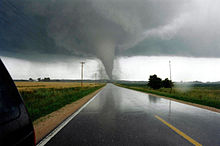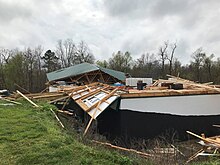Portal:Tornadoes
Note: Tornadoes are very dangerous and potentially deadly. Always take tornado warnings seriously and immediately seek shelter. |
The Tornadoes Portal

Selected tornado article -
The Storm Prediction Center (SPC) is a US government agency that is part of the National Centers for Environmental Prediction (NCEP), operating under the control of the National Weather Service (NWS), which in turn is part of the National Oceanic and Atmospheric Administration (NOAA) of the United States Department of Commerce (DoC).
Headquartered at the National Weather Center in Norman, Oklahoma, the Storm Prediction Center is tasked with forecasting the risk of severe thunderstorms and tornadoes in the contiguous United States. It issues convective outlooks, mesoscale discussions, and watches as a part of this process. Convective outlooks are issued for the following eight days (issued separately for Day 1, Day 2, Day 3, and Days 4–8), and detail the risk of severe thunderstorms and tornadoes during the given forecast period, although tornado, hail and wind details are only available for Days 1 and 2. Day 3, as well as 4–8 use a probabilistic scale, determining the probability for a severe weather event in percentage categories (15%/yellow and 30%/orange). (Full article...)Selected tornado list -

Selected image -

Selected tornado year -
Related portals
2024 tornado activity
Tornado anniversaries
May 19
- 1960 – An F4 tornado caused major damage in Meriden, Kansas, killing one person and injuring 91. In town, 64 homes were destroyed and 148 were damaged. Another F4 tornado, rated F5 by Thomas P. Grazulis, damaged or destroyed dozens of farms as it moved between Ogden and Rossville, Kansas.
- 1983 – A tornado outbreak impacted the Southern United States and Michigan. An F3 tornado damaged hundreds of buildings in Urania and Olla, Louisiana, killing one person and injuring 35.
May 20
- 1957 – A catastrophic F5 tornado moved through the suburbs of Kansas City, Missouri, with the worst damage in Ruskin Heights, sweeping away many homes, killing 37 people, and injuring at least 500. This tornado, or a previous member of the tornado family killed 7 others in Kansas including 5 near Spring Hill.
- 2013 – A large EF5 tornado devastated parts of Moore, Oklahoma, killing 23 people. It was the second F5 or EF5 tornado to affect Moore, the other striking in 1999. Seven of the dead were students at Plaza Towers Elementary School. Damage totaled $2 billion, one of the costliest tornadoes in U.S. history.
May 21
- 1918 – A major tornado outbreak impacted Iowa and Wisconsin, killing 27 people. An F4 (possibly F5) tornado devastated Boone, Iowa and completely swept away two farms, killing nine people. Another F4 tornado destroyed most of Lone Rock, Wisconsin, killing four people there, and four more on farms. An F5 tornado killed four people as it destroyed at least 20 farms between Densison and Adaza, Iowa.
- 1949 – A tornado outbreak, continuing from the previous day, killed 51 people across the Midwestern United States. An F4 tornado destroyed more than 200 homes in Cape Girardeau, Missouri, killing 23 people and injuring 130. Another F4 tornado devastated Shelburn, Indiana, killing 14 people, injuring 251, and destroying 160 homes.
Did you know…
- ...that the 2013 Moore tornado that struck Moore and Newcastle, Oklahoma, is the most recent EF5 tornado?
- ...that the 2021 South Moravia tornado, an IF4 tornado with winds between 207–260 mph (333–418 km/h), was the strongest tornado to hit the Czech Republic in modern history?
General images -

Although historically the U.S. state of Connecticut is not typically known to fall casualty to tornadoes, more than 100 of these powerful storms have affected the state in modern history, resulting in at least 48 deaths, 780 injuries, and more than $500 million in damage. This list of tornadoes in the state is likely incomplete, as official records date back only to 1950 for tornadoes in the United States.
As with most of the northeastern United States, the number of tornadoes peaks in the summer months, normally in July or August. Hartford County has had the most tornadoes in the state, although since 1950 Litchfield County has reported the most tornadoes. Several areas have been struck more than once, and Waterbury has been struck by no less than four tornadoes since 1955. (Full article...)List of Featured articles and lists
|
|---|
Topics
Subcategories
Related WikiProjects
The scope of WikiProject Severe weather is to write articles about severe weather, namely thunderstorms and tornadoes. Their talk page is located here.
WikiProject Weather is the main hub for all articles that are weather-related. WikiProject Weather strives to improve articles in a variety of weather topics, including Tropical Cyclones, Severe Weather, General meteorology, Non-tropical Storms, Climate, Floods, Droughts and wildfires, Meteorological instruments and data, Meteorological Biographies, and Space Weather. If you would like to help, please visit the project talk page.
WikiProject Meteorology is a collaborative effort by dozens of Wikipedians to improve the quality of meteorology- and weather-related articles. If you would like to help, visit the project talk page, and see what needs doing. The project is currently being merged into WikiProject Weather.
WikiProject Tropical cyclones is a daughter project of WikiProject meteorology. The dozens of semi-active members and several full-time members focus on improving Wikipedia's coverage of tropical cyclones.
Wikipedia is a fully collaborative effort by volunteers. So if you see something you think you can improve, be bold and get to editing! We appreciate any help you can provide!
Things you can do
Wikimedia
The following Wikimedia Foundation sister projects provide more on this subject:
-
Commons
Free media repository -
Wikibooks
Free textbooks and manuals -
Wikidata
Free knowledge base -
Wikinews
Free-content news -
Wikiquote
Collection of quotations -
Wikisource
Free-content library -
Wikiversity
Free learning tools -
Wikivoyage
Free travel guide -
Wiktionary
Dictionary and thesaurus









































